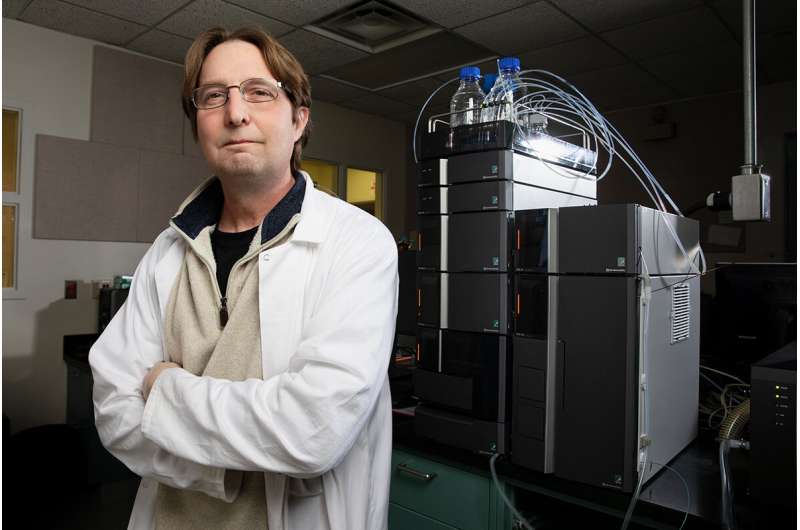John Scott, a senior chemist with the Illinois Sustainable Technology Center, says per- and polyfluoroalkyl substances are widespread, long-lasting and extremely difficult to remove from the environment. Credit: L. Brian Stauffer
Following action by the federal Environmental Protection Agency, the state of Illinois is investigating the occurrence of per- and polyfluoroalkyl substances in community water supplies across the state, with an eye toward developing policies to reduce their use. Exposure to PFAS has been linked to increased risk of certain cancers and potential developmental problems in children. News Bureau life sciences editor Diana Yates spoke about the issue with John Scott, a senior chemist with the Illinois Sustainable Technology Center.
Why are PFAS used in so many products?
PFAS are used in packaging, nonstick cookware, water-resistant carpeting, construction materials, firefighting foam, and personal-use products like shampoos and dental floss.
PFAS have unique properties. They are very resistant to water, oil and most things that would stain surfaces. They also are thermally stable, resistant to degradation and great friction reducers.
Why are they so problematic?
There are more than 5,000 compounds classified as PFAS, and the list seems to be growing every day. This makes monitoring, regulating and treating them a much more difficult task.
What makes PFAS so useful is also what makes them so problematic. For starters, they are very water soluble, which means they can reach very high concentrations in surface and groundwaters contaminated by them. This also makes them very mobile in the environment, so they can readily move from soil to water to organisms. PFAS also are known to bioaccumulate. This means they can be present at higher concentrations in wildlife and humans than in the surrounding environment.
Since PFAS are so stable, they are extremely persistent in the environment. Carbon-fluorine bonds are some of the strongest chemical bonds known. This is why these compounds are so hard to break down. Once they get into the environment, they pretty much stick around forever. This is also why treatment of PFAS is so difficult. We can readily get PFAS to adsorb to many materials, but it isn't clear what to do with those materials afterward. It requires a great deal of energy and cost to destroy PFAS, and the process may create even more potentially toxic degradation products or hazardous air pollutants. The only alternative is to landfill these materials, but that gives them the potential to be released back into the environment.
How widespread is the problem in Illinois?
In reference to PFAS, one will typically hear the word "ubiquitous." It seems that everywhere we look for PFAS, they turn up. This is true in Illinois.
Illinois does have some "PFAS hot spots" that I am aware of. These sites are typically where fires have been treated with aqueous firefighting foams, locations where training with these foams has occurred and air force bases. These hot spots usually have very high concentrations of PFAS in their soils and nearby groundwaters and surface waters. Michigan has many sites where illegal dumping of PFAS occurred, but I am unaware of any sites like that in Illinois. That doesn't mean they don't exist.
Many PFAS-laden materials are dumped in landfills and, as a result, high concentrations of PFAS can end up in landfill leachates. These leachates are commonly sent to wastewater treatment plants, which are not currently designed to treat PFAS. This means the PFAS are either directly discharged to the environment via effluent or they contaminate the sewage sludge, commonly referred to as biosolids. Because biosolids from wastewater treatment plants are sometimes used as fertilizer on agricultural crops, the PFAS are then released back into the environment. When considering the potential impact, it's good to keep in mind that Illinois has 37 active landfills and many more that are inactive or closed.
Are there safer alternatives to PFAS?
Many alternative chemicals have been developed and implemented to replace the traditional PFAS. However, the consensus of the scientific community is that they are just as problematic as the compounds they replaced. The Department of Defense is aggressively looking for fluorine-free alternatives.
How might the state of Illinois address the problem?
In the hierarchy of pollution prevention, source reduction is the most efficient approach. We need to reduce the amount of PFAS we produce and the amount of PFAS we use, and find safer alternatives that have minimal environmental impact. Education is an essential part of this process. Making the public aware of the issue would be a great place to start.
I suspect that many people purchasing materials containing PFAS are not even aware of it. A requirement for labeling of materials that contain PFAS may provide consumers with a means to make the right decision with their purchasing power. This also could provide a way for solid waste managers to divert these materials so that they are not released back into the environment. Even if we stopped all use of PFAS tomorrow, however, I suspect that we will be dealing with their legacy for decades to come.
Provided by University of Illinois at Urbana-Champaign























